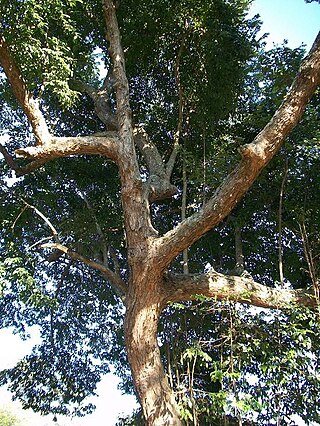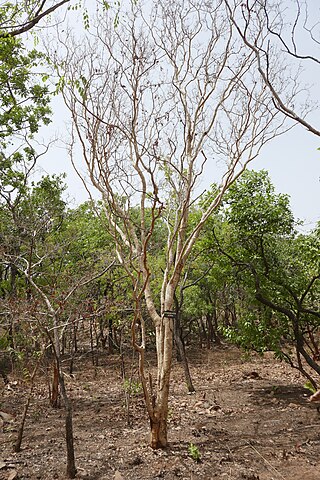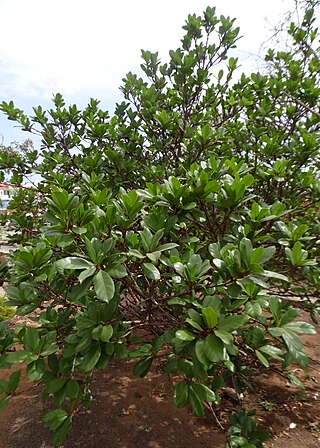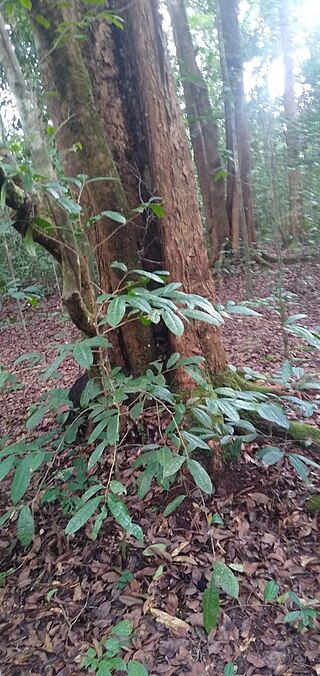
Ricinodendron is a plant genus in the family Euphorbiaceae first described as a genus in 1864. It includes only one known species, Ricinodendron heudelotii, native to tropical Africa from Senegal + Liberia east to Sudan and Tanzania and south to Mozambique and Angola. It produces an economically important oilseed. The tree is known as munguella (Angola), njangsa (Cameroon), bofeko (Zaire), wama (Ghana), okhuen (Nigeria), kishongo (Uganda), akpi, djansang, essang, ezezang and njasang. Two varieties of the tree species are recognized R. heudelotii var. heudelotii in Ghana and R. heudelotii var. africanum in Nigeria and westwards.
Guibourtia ehie is an evergreen tree of the genus Guibourtia in the family Fabaceae, also known by the common names amazique, amazoué, hyedua, black hyedua, mozambique, ovangkol and shedua.

Trilepisium, the urnfigs or false-figs, is a small Afrotropical genus of plants in family Moraceae. They grow to medium-sized or large trees that occur in evergreen and semi-deciduous forests, flooded forests or forest patches and often along rivers and streams, and at altitudes of up to 2,000 m and over.

Margaritaria discoidea is a tree in the family Phyllanthaceae, commonly known as the pheasant-berry, egossa red pear or bushveld peacock-berry. These trees are native to the warmer, higher rainfall areas of Africa.
Commiphora africana, commonly called African myrrh, is a small deciduous tree belonging to the Burseraceae, a family akin to the Anacardiaceae, occurring widely over sub-Saharan Africa in Angola, Botswana, Burkina Faso, Chad, Eswatini, Eritrea, Ethiopia, Kenya, Mali, Mauritania, Mozambique, Namibia, Niger, Senegal, Somalia, South Africa, Sudan, Tanzania, Uganda, Zambia and Zimbabwe. On sandy soils this species sometimes forms pure stands, deserving consideration as a plant community or association.

Hymenocardia acida is a plant of the family Phyllanthaceae native to tropical Africa. It is a small tree that grows to 10 m tall. Occurs in the Guinea and Sudanian savannah zones and deciduous woodland, from Senegal eastwards to Ethiopia and southwards reaching Zimbabwe.

Maerua angolensis is a 10m tall, occasionally deciduous tree of the Capparaceae or caper family, often growing on termitaria and in thickets fringing seasonal watercourses, up to 1800m. Though never common, it is widespread in tropical Africa and arid regions, being absent from high-rainfall regions.

Landolphia is a genus of flowering plants in the family Apocynaceae first described as a genus in 1806. They take the form of vines that scramble over host trees. Landolphia is native to tropical Africa.

''Ficus cyathistipula'', the African fig tree, is a species of fig that is native to the tropical forest regions of Africa. They may be small trees, shrubs or hemi-epiphytic lianas, and are widespread in the moist tropics, where they may be found in Afromontane or rainforest, often overhanging pools. The figs are reddish when ripe, and have thick, spongy walls that enable them to float on water. They are named for their cup-shaped (cyathus-) and persistent stipules (stipula).

Trilepisium madagascariense, the urnfig or false-fig, is a species of plant in the family Moraceae, with an extensive range in the subtropical and tropical Afrotropics. It grows to a medium-sized or large tree in primary or secondary forest, or in forest patches, and is rarely cultivated.

Raphia farinifera is a tropical African palm tree occurring in lowland riparian and swamp forest, also around human habitations and cultivated locations, on stream banks and other moist situations at altitudes of 50–1000 m. Found in Angola, Benin, Burkina, Cameroon, Gambia, Ghana, Guinea, Ivory Coast, Kenya, Madagascar, Malawi, Mauritius, Mozambique, Nigeria, Réunion, Senegal, Seychelles, Sierra Leone, Tanzania, Togo, Uganda, Zambia and Zimbabwe, and naturalised in east lowlands of Madagascar. Its generic epithet is derived from raphis = 'needle', probably in reference to the 4 mm long yellowish spines on the margins and main veins of the leaflets. The specific name refers to a type of starchy flour obtained from the trunk pith – farina = 'starch', fera = 'bearing'.
Anisopus mannii is a perennial herbaceous shrub in the subfamily Asclepiadoideae of the family Apocynaceae — commonly referred to as the dogbane family. The flowering species grows in the tropical environments of central Africa, and is renown in traditional Nigerian medicine for treating sexual impotence, the common cold, diarrhea, and most notably, its potent hypoglycemic effect. Recent research has been conducted, looking in to the species' potential anti-diabetic, anti-inflammatory, analgesic, antimicrobial, and antioxidant bioactivities and mechanisms of action.
Erythrophleum ivorense is a species of leguminous tree in the genus Erythrophleum found in the rainforests of tropical West and Central Africa. The tree has many uses; the timber is used for heavy construction, for making charcoal and for firewood, the bark is used for tanning and in traditional medicine, and both bark and seeds are poisonous and used for hunting.

Lannea welwitschii is a species of tree in the family Anacardiaceae. It is native to the tropical rainforests of West and Central Africa. The timber is used to make furniture and utensils and for many other purposes, the fruits can be eaten, and the bark is used to produce a dye, for making rope and in traditional medicine.

Brachystegia laurentii, a plant in the family Fabaceae, is a species of large tree found in western Cameroon, Gabon, Equatorial Guinea, the Democratic Republic of the Congo and the Republic of the Congo. It has a dense, umbrella-shaped crown. The wood is known as bomanga and has many uses in building and construction.
Vitex thyrsiflora is a species of woody vine in the family Lamiaceae. It is native to tropical West and Central Africa. Its hollow stem is used as a home by an aggressive species of ant.

Garcinia mannii is a dioecious and evergreen flowering tree in the family Clusiaceae (Guttiferae). The specific epithet (mannii) honors German botanist Gustav Mann.

Sacoglottis gabonensis, commonly known as bitterbark tree or cherry mahogany is a medium to large sized evergreen tree within the Humiriaceae family. It is the only species within the genus, Sacoglottis that is native to tropical Africa, another, guianensis Benth. being native to Amazonia. It occurs in rainforests or on sandy soils of Senegal eastwards to Angola in central Africa. It is traded locally and known in some countries under the name Ozouga.

Cassipourea malosana is a species of plant native to tropical Africa.
Baccharoides lasiopus is a thinly branched herb or semi shrub within the family Asteraceae.

















